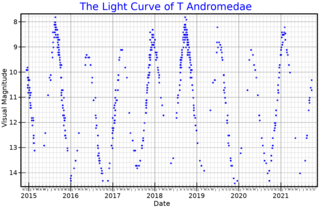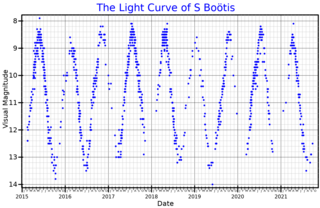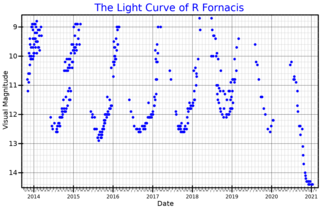
U Antliae is a variable star in the constellation Antlia. It is a carbon star surrounded by two thin shells of dust.

28 Andromedae is a Delta Scuti variable star in the constellation Andromeda. 28 Andromedae is the Flamsteed designation. It also bears the variable star name GN Andromedae. Its apparent magnitude is 5.214, varying by less than 0.1 magnitudes.

R Centauri is a Mira variable star in the constellation Centaurus.
Z Andromedae is a binary star system consisting of a red giant and a white dwarf. It is the prototype of a type of cataclysmic variable star known as symbiotic variable stars or simply Z Andromedae variables. The brightness of those stars vary over time, showing a quiescent, more stable phase and then an active one with a more pronounced variability and stronger brightening and/or dimming.

R Andromedae is a Mira-type variable star in the constellation Andromeda. Its spectral class is type S because it shows absorption bands of zirconium monoxide (ZrO) in its spectrum. It was among the stars found by Paul Merrill to show absorption lines of the unstable element technetium, establishing that nucleosynthesis must be occurring in stars. The SH molecule was found for the first time outside earth in the atmosphere of this star. The star is losing mass due to stellar winds at a rate of 1.09×10−6M☉/yr.

T Andromedae is a variable star of the Mira type in the constellation Andromeda. Like all the stars of this kind, T And is a cool asymptotic giant branch star of spectral type M4e-M7.5e. Its brightness varies periodically, completing a cycle in 281 days. The peak luminosity, however, is different every variability cycle, but can reach a peak magnitude mv=7.70.

R Reticuli, also listed under the duplicate variable star designation S Reticuli, is a Mira variable star in the southern constellation Reticulum. It is an aging red giant star on the asymptotic giant branch with a stellar classification that varies between M4e to M7.5e, being hottest near maximum visual magnitude. The brightness of the star varies between apparent visual magnitudes 6.35 and 14.2 with an average period of 281.08±0.58 d. The mean maximum magnitude is 7.57 and the mean minimum magnitude 13.80.

R Boötis is a variable star in the northern constellation of Boötes. Typically the star is too faint to be readily visible to the naked eye, with a brightness that fluctuates between apparent visual magnitudes of 9.98. The distance to this star is approximately 2,150 light years based on parallax measurements. It is drifting closer with a radial velocity of about −58 km/s.

W Andromedae is a variable star in the constellation of Andromeda. It is classified as a Mira variable and S-type star, and varies from an apparent visual magnitude of 14.6 at minimum brightness to a magnitude of 6.7 at maximum brightness, with a period of approximately 397.3 days. The star is losing mass due to stellar winds at a rate of 2.79×10−7M☉/yr.

RV Andromedae is a variable star in the constellation of Andromeda. It is classified as a semiregular variable pulsating giant star, and varies from an apparent visual magnitude of 11.5 at minimum brightness to a magnitude of 9.0 at maximum brightness, with a period of approximately 168.9 days.

RX Andromedae is a variable star in the constellation of Andromeda. Although it is classified as a dwarf nova of the Z Camelopardalis (UGZ) type, it has shown low-luminosity periods typical of VY Sculptoris stars. However, for most of the time it varies from an apparent visual magnitude of 15.1 at minimum brightness to a magnitude of 10.2 at maximum brightness, with a period of approximately 13 days.

U Orionis is a Mira-type variable star in the constellation Orion. It is a classical long period variable star that has been well observed for over 120 years.

R Equulei is a class M Mira variable star in the constellation Equuleus. Its brightness varies between a minimum magnitude of 15.0 to a maximum of 8.7 with an average period of 261 days.

S Canis Minoris is a variable star in the equatorial constellation Canis Minor. It has a peak apparent visual magnitude of 6.5, so not normally visible to the naked eye. The star is located at a distance of approximately 1,360 light-years from the Sun based on stellar parallax, and is drifting further away with a radial velocity of about +68 km/s.

S Boötis is a Mira variable in the constellation Boötes. It ranges between magnitudes 7.8 and 13.8 over a period of approximately 270 days. It is too faint to be seen with the naked eye, however when it is near maximum brightness it can be seen with binoculars.

U Microscopii is a Mira variable star in the constellation Microscopium. It ranges from magnitude 7 to 14.4 over a period of 334 days. The Astronomical Society of Southern Africa in 2003 reported that observations of U Microscopii were very urgently needed as data on its light curve was incomplete.

W Aquilae is a variable star in the constellation of Aquila. It is a type of evolved star known as an S-type star. Due to its relatively close distance of 1,200 light-years and equatorial location, it is easy to observe and heavily studied.

S Cassiopeiae is a Mira variable and S-type star in the constellation Cassiopeia. It is an unusually cool star, rapidly losing mass and surrounded by dense gas and dust producing masers.
QV Andromedae is an Alpha2 Canum Venaticorum variable in the constellation Andromeda. Its maximum apparent visual magnitude is 6.6, so it can be seen by the naked eye under very favourable conditions. The brightness varies slightly following a periodic cycle of approximately 5.23 days.

R Fornacis is a Mira variable and carbon star located in the constellation Fornax. It is around 1,800 light years away based on parallax measurements.


















